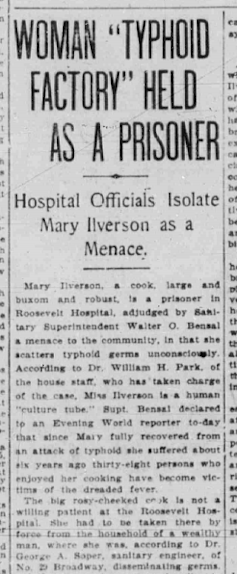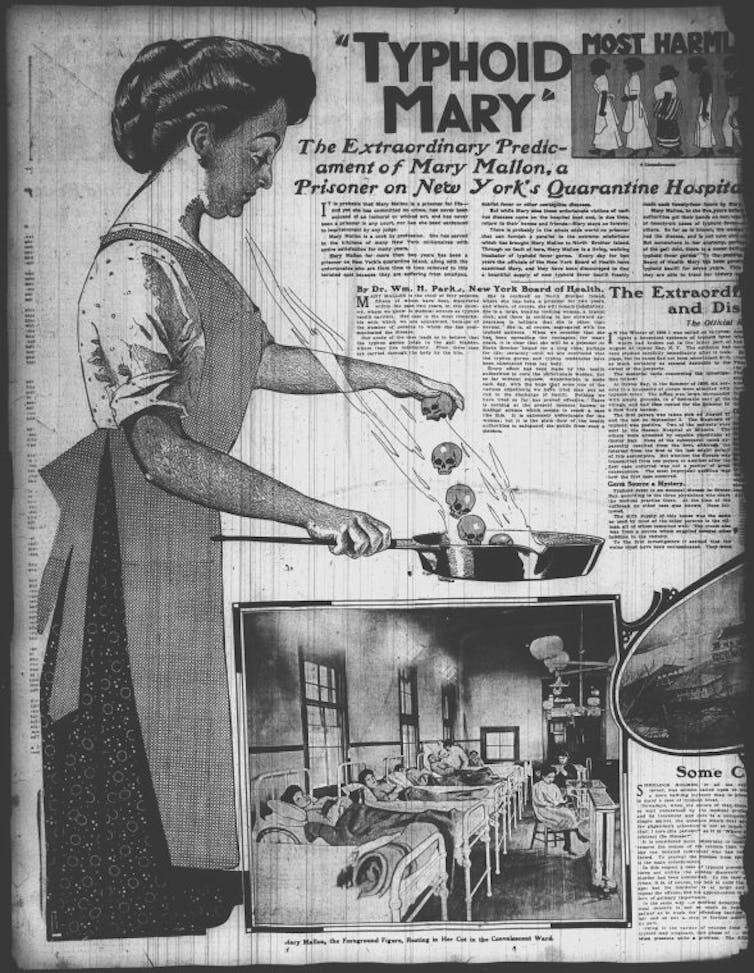The country’s most notable healthy carrier of a deadly disease, Mary Mallon, is back – not in person, but as a hashtag: #TyphoidMary.
In the current pandemic, people may unknowingly harbour and spread the coronavirus before they feel sick, largely because it has an incubation period of between two and 14 days. The Centers for Disease Control and Prevention now says that one in four people could be asymptomatic carriers, never showing symptoms even as they infect others.
But there are also those who, knowing they could be carriers, refuse to cover their mouths or practice social distancing. They include the spring breakers who crowded Florida beaches and the protesters gathering in some state capitals.
Mary Mallon, known as Typhoid Mary, was until now the most prominent example in the US of the unknowing disease carrier. She spread typhoid fever to at least 53 people, causing three deaths between 1900 and 1915.
But Mallon has long been unfairly characterised as knowingly spreading the deadly disease she carried. Her memory has been resurrected recently, largely on Twitter, as a shorthand description of those who intentionally infect others with the coronavirus, #TyphoidMary.
As the author of Constructing the Outbreak: Epidemics in Media and Collective Memory, I can attest to the media’s past and continuing distortion of the Mary Mallon case. It’s unfair to Mallon to attach her name to such consciously bad behaviour.
Mary Mallon, the healthy carrier
Contrary to popular belief, Mallon never perceived herself to be contagious. During her famous trial of 1909, newspapers quoted her saying, “I was cook for Mr. Stebbins’ family and other families, and nobody fell sick while I was there.”
Like many people in her era, Mallon could not fathom that a healthy-looking person could transmit disease. Throughout her life, she swore her innocence, claiming that she had never had the disease.
The popular – and mistaken – beliefs about Mallon came primarily from media accounts during her life. But the mischaracterisation of Mallon continued long after.
Mallon unknowingly spread typhoid fever through the dishes she prepared, mostly for wealthy families in New York. In the summer of 1906, she cooked for the Warren family at their rental house at Long Island’s Oyster Bay. From August 26 through September 3, typhoid fever struck six out of 11 members of the household.
The homeowners hired George Soper, a self-proclaimed “sanitary engineer,” to investigate. He eventually traced the Oyster Bay outbreak to the new cook, along with typhoid at six of her other places of employment.
Soper’s discovery prompted the New York City Health Inspector Dr. Josephine Baker and the police department to take Mallon by force to a nearby hospital.
Against her will, she underwent multiple physical examinations that included stool samples, which revealed the Salmonella typhi bacteria. Mallon was then quarantined at North Brother Island, a refuge for those ill with tuberculosis and other contagious diseases, for two years without a charge or trial.
Mallon hired attorney George O’Neill, who petitioned for her release on June 28, 1909. Before a judge, she testified that she was healthy and had never made others ill. The judge denied her request on the grounds that she was a threat to public health and ordered her to continue living isolated at North Brother Island.
Becoming ‘Typhoid Mary’
Approximately 400 other healthy carriers had also been identified in New York at the time of Mallon’s trial. Unlike Mallon, they were not arrested, tried and imprisoned for years.
It was Mallon’s status as a poor, Irish immigrant woman that made her susceptible to becoming the city’s scapegoat. Soper himself initially described her as “an Irish woman about 40 years of age, tall, heavy, single.” Newspapers treated Mallon as either a “germ receptacle” or as a wild animal to be contained. “Woman ‘Typhoid Factory’ Held As a Prisoner,” stated one headline. “Witch In N.Y.” read a Tacoma Times headline. The story included this description of Mallon: “Legendary witches of old used to build red fires…and brew deadly potions…But poor ‘Typhoid Mary’… requires no cauldron. She manufactures WITHIN HERSELF the evil potions which she spreads about.”
Facts about the case came from Soper and public health authorities to medical journals and newspapers, mentioning her ethnicity, appearance and marital status. Such characteristics were not identified in stories of other healthy carriers. Mallon was never interviewed and therefore did not get to give her perspective, other than in reprinted segments of a single letter to her attorney, in which she declared her innocence.
Government officials and the media justified Mallon’s loss of civil liberties by framing her as a particular danger to public health, more than other healthy carriers.
Her infamous nickname, coined at a 1908 medical conference and then repeated in an edition of the Journal of the American Medical Association, shifted Mallon’s public persona from human incubator to villain – an image introduced in the New York American newspaper on June 20, 1909.
The headline “‘Typhoid Mary’: The Extraordinary Predicament of Mary Mallon, a Prisoner on New York’s Quarantine Hospital Island,” extended over a full-page drawing of a cook sautéing a cluster of skulls in her cast-iron skillet. This introduction forever cemented the misconception that Mallon’s disease transmission was murderously intentional.
From that point, news stories compared “Typhoid Sally,” “Diphtheria Mildred” and other healthy carriers to “Typhoid Mary.” While some were briefly detained at hospitals after unintentionally causing outbreaks, no one was treated as poorly as Mallon.
Perpetuating ‘Typhoid Mary’
Mallon was finally released in 1910. With a lack of options (and without an understanding of healthy carriers), Mallon began cooking again, this time at restaurants, hotels and, lastly, the Sloane Hospital for Women. When more than 20 cases of typhoid erupted at the hospital, authorities identified Mallon as the source.
On March 26, 1915, the New York City Department of Public Health escorted Mallon back to North Brother Island. She lived and worked at the hospital there until she died in 1938. There is no record of typhoid outbreaks during her stay.
Even after her final detention and death, newspapers and popular culture perpetuated the misconception that Mallon infected people intentionally, channeling her natural poison (typhoid) through the food she cooked. Books like Terrible Typhoid Mary: A True Story of the Deadliest Cook in America, television references and the eponymous comic book character have preserved this image of a villainous Mallon.
Across media platforms, “Typhoid Mary” is still casually applied to contemporary menaces of public health, ignoring the ethically dubious practice of blaming healthy carriers and Mary Mallon’s persecution as a poor immigrant at the turn of the 20th century.
Katherine A. Foss, Professor of Media Studies, Middle Tennessee State University
This article is republished from The Conversation under a Creative Commons license. Read the original article.


